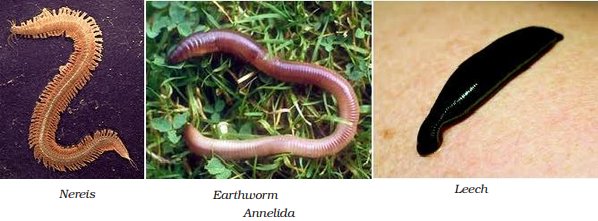
Salient features of Annelids
- They are mostly aquatic and few are terrestrial forms.
- Most of them are free living and some are ectoparasites.
- The body is elongated, cylindrical or flattened. It is divided into segments by ring-like grooves called annuli.
- True metameric segmentation is present. The number of segments is fixed with no gain or loss of segments in their life.
- Body is triploblastic and bilaterally symmetrical.
- They have tube within a tube body plan.
- The body cavity is a true coelom (schizocoelomate or eucoelomate), as it is lined by mesodermal epithelium.
- Alimentary canal is complete and segmentally arranged. It is divided by vertical septa into compartments.
- Circulatory system is of closed type, and appears for the first time in animal kingdom.
- Blood is red in color due to haemoglobin (Hb) which dissolves in plasma.
- The heart is neurogenic.
- Respiratory organs are absent, so gaseous exchange occurs by general body surface.
- Excretory system consists of coiled tubes, the nephridia which are ectodermal in origin.
- They may be ammonotelic or ureotelic.
- They are hermaphrodite and sexual reproduction occurs with the formation of gametes.
- Fertilization may be internal or external.
- Development may be direct (with no larval stage) or indirect (with a larval stage).
Classification:
Phylum Annelida is divided into following four classes.
Class: Polychaeta
- They are marine forms.
- Body bears a distinct head that consists of two pairs of eyes and tentacles.
- Body is segmented with unjointed locomotory appendages called parapodia.
- Parapodia bears setae which are long and numerous. Setae help in fixation.
- Clitellum is absent.
- Sexes are separate and fertilization is internal in water.
- Development includes a larval stage called Trochophore
- e.g. Nereis (the sandworm), Aphrodite (the sea mouse), Chaetopterus (the paddle worm) etc.
Class: Oligochaeta
- They may be either aquatic or terrestrial.
- Body lacks a head and the locomotory organs are setae.
- Setae are small and many in number which arise from setigerous
- Clitellum is present throughout the life.
- Sexes are united (hermaphrodite) and fertilization is external.
- Development is direct.
- e.g. Pheretima ( the earthworm), Tubifex (the blood worm) etc.
Class: Hirudinea
- They are found in damp and moist places and few are ectoparasites.
- Parasitic forms are sanguivorous and consist of an anticoagulant (Hirudin) in their saliva.
- Body is segmented and the number of segments is fixed, i.e 33 segments.
- Body lacks a head and setae.
- They are haemocoelomate and circulatory system is of open type.
- Clitellum is temporary and develops during the breeding season, in 19th to 11th
- Five pairs of dorsal eyes are present.
- Alimentary canal is complete with many crop and caeca.
- There is an anterior sucker and often a posterior sucker for locomotion and feeding blood.
- In leech, mesoderm splits and forms Botryoidal tissue which is excretory in nature.
- Sexes are separate and development is direct.
- e.g. Hirudinaria (the cattle leech), Pontobdella (the fish leech) etc.
Class: Archinnelida
- They are exclusively marine.
- Head is with tentacles and sense organ.
- Parapodia and setae are usually absent.
- External segmentation is faint, internal segmentation is formed by septa.
- Sexes may be separate or united.
- Development includes a larval stage called trochophore larva.
- e.g. Polygordius (living fossil), Protodrillus etc.